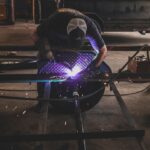Diode laser hair removal is a popular method for achieving long-lasting hair reduction. This technology utilizes a specific wavelength of light that targets the melanin in hair follicles, effectively damaging them to inhibit future hair growth. The diode laser is particularly effective for individuals with darker hair and lighter skin, as the contrast allows for better absorption of the laser energy.
However, advancements in technology have made it possible for diode lasers to treat a wider range of skin tones and hair types, making this method accessible to more people than ever before.
During the treatment, a handheld device emits laser light onto the skin, which is often accompanied by a cooling mechanism to minimize discomfort.
Many patients report feeling a slight tingling sensation, akin to the snap of a rubber band against the skin. The effectiveness of diode laser hair removal lies in its ability to target hair during the active growth phase, known as the anagen phase. Since not all hair follicles are in this phase at the same time, multiple sessions are typically required to achieve optimal results.
Key Takeaways
- Diode laser hair removal uses a concentrated beam of light to target and destroy hair follicles, leading to permanent hair reduction.
- The number of sessions required for diode laser hair removal can be affected by factors such as hair color, skin color, and hair thickness.
- Different body areas may require a different number of sessions for optimal results, with larger areas like the legs typically requiring more sessions than smaller areas like the underarms.
- Potential side effects of diode laser hair removal include redness, swelling, and skin irritation, but these are usually temporary and can be minimized with proper care.
- Before diode laser hair removal sessions, it is important to avoid sun exposure, waxing, and plucking to ensure the best results and minimize the risk of complications.
Factors Affecting Number of Sessions
Hair Type and Color
Darker, coarser hair tends to respond better to laser treatments because it absorbs more light energy compared to finer or lighter-colored hair. This means that individuals with darker hair may require fewer sessions to achieve satisfactory results.
Skin Type and Tone
Your skin type and tone also play a significant role in determining the number of sessions needed. Individuals with lighter skin generally experience better outcomes with fewer sessions, as the contrast between the skin and hair color allows for more precise targeting of the hair follicles. On the other hand, those with darker skin tones may require additional treatments due to the increased risk of overheating the surrounding skin tissue.
Hormonal Factors
Hormonal factors can also impact the number of sessions needed for effective diode laser hair removal. Certain conditions, such as polycystic ovary syndrome (PCOS), can lead to increased hair growth, necessitating more frequent sessions to manage unwanted hair effectively.
Recommended Number of Sessions for Different Body Areas

The recommended number of sessions for diode laser hair removal can vary significantly depending on the area being treated. For smaller areas like the upper lip or chin, you might need around 6 to 8 sessions spaced about 4 to 6 weeks apart. These areas typically have finer hair and may respond more quickly to treatment.
In contrast, larger areas such as the legs or back may require 8 to 12 sessions or even more, as these regions often have denser and coarser hair. It’s also important to consider individual growth cycles when determining how many sessions you will need. Hair on different parts of your body grows at varying rates; for instance, facial hair tends to grow faster than leg hair.
Therefore, while you may achieve satisfactory results on your upper lip in a shorter timeframe, your legs may require additional sessions to reach the same level of hair reduction. Consulting with a professional can help you establish a tailored plan that considers these factors.
Potential Side Effects and Complications
| Side Effect/Complication | Description |
|---|---|
| Pain | Discomfort or soreness at the injection site |
| Swelling | Localized swelling or redness at the injection site |
| Fever | Low-grade fever or flu-like symptoms |
| Headache | Mild to moderate headache |
| Nausea | Feeling of queasiness or upset stomach |
| Allergic Reaction | Rash, itching, or difficulty breathing |
While diode laser hair removal is generally considered safe, it is essential to be aware of potential side effects and complications that may arise. Common side effects include temporary redness, swelling, and mild discomfort in the treated area. These symptoms usually subside within a few hours to a couple of days following treatment.
However, some individuals may experience more pronounced reactions, such as blistering or changes in skin pigmentation, particularly if they have darker skin tones. In rare cases, complications can occur, such as scarring or infection. These risks can be minimized by choosing a qualified practitioner who uses appropriate techniques and equipment.
It’s crucial to follow pre- and post-treatment care instructions provided by your practitioner to reduce the likelihood of adverse effects.
Preparing for Diode Laser Hair Removal Sessions
Preparation is key to ensuring a successful diode laser hair removal experience. Before your first session, you should schedule a consultation with your practitioner to discuss your medical history and any medications you are currently taking. This step is vital because certain medications can increase sensitivity or affect how your skin reacts to laser treatment.
Your practitioner will also assess your skin type and hair color to determine the most effective settings for your treatment. In the weeks leading up to your appointment, it’s essential to avoid sun exposure and tanning beds, as tanned skin can increase the risk of complications during treatment. Additionally, refrain from waxing or plucking hairs in the treatment area for at least four weeks prior to your session; shaving is usually recommended instead, as it leaves the hair follicle intact while removing surface hair that could interfere with the laser’s effectiveness.
Following these guidelines will help ensure that you achieve optimal results from your diode laser hair removal sessions.
Post-Treatment Care and Maintenance
After undergoing diode laser hair removal, proper post-treatment care is crucial for maximizing results and minimizing side effects. Immediately following your session, you may notice some redness or swelling in the treated area; applying a cool compress can help alleviate discomfort. It’s also advisable to avoid hot showers, saunas, or strenuous exercise for at least 24 hours post-treatment, as these activities can exacerbate irritation.
In the days following your session, keep an eye on the treated area for any signs of adverse reactions such as blistering or excessive redness. If you experience any concerning symptoms, don’t hesitate to reach out to your practitioner for guidance. Additionally, it’s important to continue avoiding sun exposure and using sunscreen on treated areas for several weeks after treatment to protect your skin and prevent pigmentation changes.
Consultation and Customized Treatment Plans
A thorough consultation is essential before beginning diode laser hair removal treatments. During this initial meeting, you will have the opportunity to discuss your goals and expectations with your practitioner. They will evaluate your skin type, hair color, and medical history to create a customized treatment plan tailored specifically for you.
This personalized approach ensures that you receive the most effective treatment while minimizing potential risks. Your practitioner will also explain what you can expect during each session and how many treatments are likely necessary based on your individual characteristics. This transparency helps set realistic expectations and allows you to make informed decisions about your treatment journey.
Remember that open communication with your practitioner is vital; don’t hesitate to ask questions or express any concerns you may have throughout the process.
Tips for Maximizing Results and Minimizing Sessions
To maximize the effectiveness of diode laser hair removal and potentially reduce the number of sessions required, there are several strategies you can implement. First and foremost, adhere strictly to your treatment schedule as recommended by your practitioner. Consistency is key when it comes to targeting hair follicles during their active growth phase.
Additionally, maintaining healthy skin can enhance treatment outcomes. Keep your skin well-hydrated and moisturized before and after sessions; this not only improves comfort but also promotes healing. Avoiding harsh skincare products or treatments in the weeks leading up to your appointments can also help maintain skin integrity.
Lastly, consider discussing any hormonal imbalances with your healthcare provider if you notice excessive hair growth despite treatment. Addressing underlying issues can significantly improve your results and help you achieve smoother skin more efficiently. In conclusion, diode laser hair removal offers an effective solution for long-term hair reduction when approached with proper understanding and care.
By considering factors such as hair type, skin tone, and individual growth cycles, you can work with a qualified practitioner to develop a personalized treatment plan that meets your needs while minimizing potential side effects. With careful preparation and diligent post-treatment care, you can enjoy the benefits of smooth skin with fewer sessions than traditional methods would require.
If you are considering diode laser hair removal, you may be wondering how many sessions are needed for optimal results. According to a Reddit thread discussing this topic, users have shared their experiences and recommendations for the number of sessions required. For more information on this topic, you can check out this related article on inlaserhairremoval.com.
FAQs
What is diode laser hair removal?
Diode laser hair removal is a cosmetic procedure that uses a concentrated beam of light to remove unwanted hair. The diode laser targets the pigment in the hair follicle, damaging the follicle and inhibiting future hair growth.
How many sessions are typically needed for diode laser hair removal?
The number of sessions needed for diode laser hair removal varies depending on individual factors such as hair color, hair thickness, and skin tone. On average, most people require 6-8 sessions spaced 4-6 weeks apart to achieve optimal results.
Why are multiple sessions necessary for diode laser hair removal?
Multiple sessions are necessary for diode laser hair removal because hair grows in different stages and the laser can only effectively target hair in the active growth phase. By spacing out the sessions, it ensures that all hair follicles are treated during their active growth phase.
Are touch-up sessions needed after completing a full course of diode laser hair removal?
Some individuals may require occasional touch-up sessions after completing a full course of diode laser hair removal to maintain the results. The need for touch-up sessions can vary depending on factors such as hormonal changes, aging, and genetics.
What are the potential side effects of diode laser hair removal?
Potential side effects of diode laser hair removal may include temporary redness, swelling, and mild discomfort in the treated area. In rare cases, there may be changes in skin pigmentation or blistering. It is important to consult with a qualified practitioner to minimize the risk of side effects.







